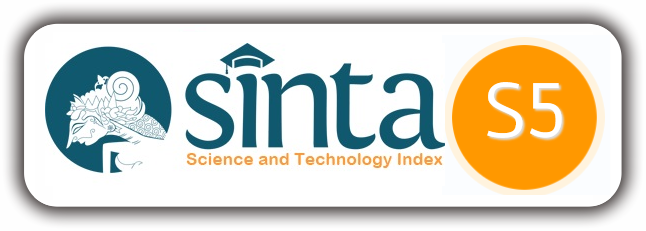ANALISIS PENERIMAAN PENGGUNA DALAM PENERAPAN ERP ATAS TEMUAN AUDIT INTERNAL PADA PT PERKEBUNAN NUSANTARA III ( PERSERO)
Eka Christine Rebeca Simanjuntak(1*), Syaiful Ali(2)
(1) Universitas Gadjah Mada, Yogyakarta
(2) Departemen Akuntansi, Fakultas Ekonomika dan Bisnis, Universitas Gadjah Mada, Yogyakarta
(*) Corresponding Author
Abstract
The research aimsto analyze the significant factors that influence the staff acceptance process in PT Perkebunan Nusantara III (Persero) through the implementation of enterprise resource planning (ERP) system. The conceptual framework was developed through the unified theory of acceptance and use of technology (UTAUT) model. The advancement of technology serves as an important feature in the company’s plan to improve their business competition level and to meet the growing users’ expectation. This research employed the mixed method approach. The quantitative data were obtained through closed-ended questionnaires from 127 users. The quantitative data were analyzed using the SPSS 21. Meanwhile, the qualitative data were collected through deep interviews with four users.
The research results indicate that performance expectation, effort expectation, and social influence have positive contributions to behavioral intention. Meanwhile, the facilitating conditions have negative contributions to behavioral intention. In addition, the research also indicated that behavioral intention has significant influence to the users’ behavior. Qualitative data analysis showed that the aspects that might influence the users’ expectation in implementing such system are educational background, age, working period, and topographic condition.
Keywords
Full Text:
PDFReferences
Daftar Pustaka Andersson, A., dan Wilson, T. L. 2011. Contracted ERP Projects Sequential progress, mutual learning, relationships, control and conflicts. International Journal of Managing Projects in Business Vol.4 , 458-479. Awwad, M. S., dan Al-Majali, S. M. 2015. Electronic library services acceptance and use : An empirical validation of unified theory of acceptance and use of technology. The Electronic Library , 1100-1120. Barth, C., dan Koch, S. 2019. Critical success factors in ERP upgrade projects. Industrial Management and Data Systems , 658-675. Creswell, J., dan Clark, V. 2011. Designing and Conducting Mixed Methods Research, 2nd Edition. Thousand Oaks: Sage. Hainzelmann, R. 2017. Accounting logics as a challenge for ERP system implementation: a field study of SAP. Journal of Accounting and Organizational Change Vol.13 , 162-187. Hall, J. A. 2011. Information Technology Auditing. United States of America: South Western Cengage Learning. Hartono, J. 2008. Sistem Informasi Keperilakuan Edisi Revisi. Yogyakarta: Andi. Hartono, J. 2003. Sistem Teknologi Informasi. Yogyakarta: ANDI. Hartono, J. 2013. Sistem Teknologi Informasi Bisnis Pendekatan Strategis. Jakarta: Salemba Empat. Isalas, P., Reis, F., Coutinho, C., dan Lencastre, J. A. 2017. Emphatic technologies for distance/mobile learning: An empirical research based on the unified theory of acceptance and use of technology (UTAUT). Interactive Technology and Smart Education , 159-180. Keong, M. L., Ramayah, T., Kurnia, S., dan Chiun, L. M. 2012. Explaining intention to use an enterprise resource planning (ERP) system: an extension of the UTAUT model. Business Strategy Series Vol. 13 , 173-180. Labuschagne, C. M. 2005. A conceptual model for enterprise resource planning. Information Management and Computer Security , 144-155. Markandeya, S., dan Roy, K. 2014. ERP and SAP overview. Springer: SAP ABAP. Mehrjerdi, Y. Z. 2010. Enterprise resource planning: risk and benefit analysis. Business Strategy Series , 308-324. Miles, M. B., Huberman, A. M., dan Saldana, J. 2014. Qualitative Data Analysis Third Edition. USA: SAGE Publications. Pajk, D. 2012. Microsoft Dynamics NAV reference model. Proceedings of DYNAA, (p. 3). Pajk, D., Indihar-Stemberger, M., dan Kovacic, A. 2011. Enterprise resource planning (ERP) systems use of reference models. Perspectives in Business Informatics Research, (pp. 178-189). Springer, Berlin and Heidelberg. PT Perkebunan Nusantara III. (2018, September 1). Perkebunan Nusantara. Retrieved April 9, 2019, from Tentang PT Perkebunan Nusantara III (Persero) Holding: https://www.holding-perkebunan.com/tentang Rana, N., Dwiyedi, Y., Williams, M., dan Weerakkody, V. 2016. Adoption of Online Public Grievence Redressal System in India: Toward Developing a Unified View. Computers in Human Behavior, Volume 59 , 265-282. Seto, I. 2013. Semiotika Komunikasi Aplikasi Praktis Bagi Penelitian dan Skripsi Komunikasi. Jakarta: Mitra Wacana Media. Shang, S. S. 2012. Dual strategy for managing user resistance with business integration systems. Behaviour and Information Technology Vol. 31 , 909-925. Sinaga, R. (2016, Oktober 10). PTPN III Holding implementasi solusi ERP. Retrieved April 8, 2019, from Antaranews.com: http://m.antaranews.com/berita/589484/ptpn-iii-holding-implementasi-solusi-erp Turban, E., Pollard, C., dan Wood, G. 2018. Information Technology for Management 11th Edition. Riverstreet, Hoboken: Wiley. Venkatesh, V., Morris, M., Davis, G., dan Davis, F. 2003. User Acceptance of Information Technology: Toward a Unified View. MIS Quarterly (27:3) , 425-478. Wawan, D., dan Falahah. 2007. ERP (Enterprise Resource Planning) Menyelaraskan Teknologi Informasi dengan Strategi Bisnis. Bandung: Informatika Bandung.
Article Metrics
Refbacks
- There are currently no refbacks.
This work is licensed under a Creative Commons Attribution 4.0 International License.
______________________________________________________________________________________________________
2302 - 1500


_logo2.png)





